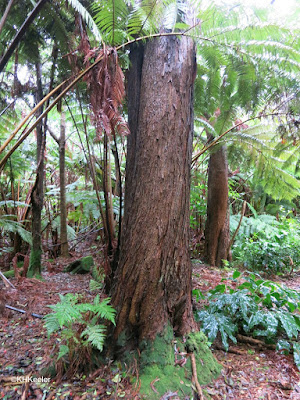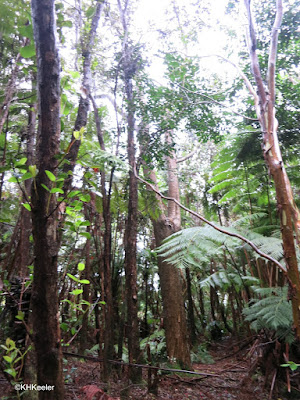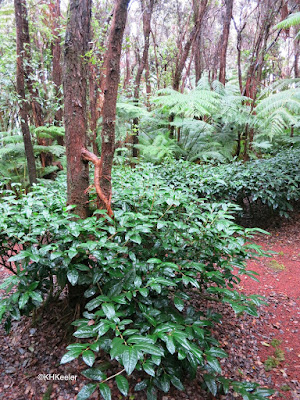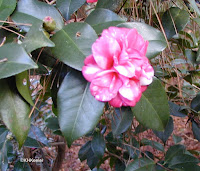 |
| tea |
Tea plants prefer temperatures between 55 and 90 oF, day and night. Chinese teas (Camelia sinensis var. sinensis) will survive the occasional light frost or snowstorm, Indian teas (Camelia sinensis var. assamica) will not. Teas grow well acidic soils, not alkaline ones. And they need water, lots of water, as humidity especially. If you have these conditions, tea plants will grow well. But not much of the U.S.--or the world for that matter--has those conditions, so tea-growing regions are quite restricted. The area around the town of Volcano, Hawaii, at 3,750' elevation on Mt. Kilauea of the Big Island, has those characteristics.
In Volcano, I visited Tea Hawaii, the plantation of Eva Lee and Chiu Leong. (website) They have been raising tea since about 2000. They are open to the public by appointment and Eva showed us around.
 |
| Unpruned tea plant |
Tea production in Hawaii is new compared to Asia. Hawaii Tea was experimenting with tea varieties and conditions for growth, but the majority of their tea was planted under the forest. The forest in Volcano is a well-developed native Hawaiian forest of tree ferns, koa (Acacia koa), mamaki (Pipturus albidus) and others. The plantation was a curious combination of neatly planted and pruned tea plants and Hawaiian native trees.
 |
| Tea under the Hawaiian forest |
 |
| koa, Acacia koa, Hawaiian native |
 |
| kahili ginger |
 |
| Forest at Hawaii Tea: no kahili ginger |
The tea is carefully hand picked: Eva demonstrates the leaves that are chosen
All tea, black, green, oolong, is from the same leaves, the difference is in the amount of fermentation and roasting. Eva showed us the dried tea leaves and let us try different teas
 |
| Unroasted, unfermented tea leaves: these make "white tea" |
 |
| Roasted and fermented tea leaves, black tea. |
Cups of tea representing a range of roasting and fermenting options
 |
| Four different fermentation levels, from none, the white tea on the left, to quite a lot, the "black" tea on the far right |
 |
| Tea under the forest view |
Comments and corrections welcome.
Kathy Keeler, A Wandering Botanist
More at awanderingbotanist.com
References
Hawaii Tea website
Jensen, Chelsea. 2017. Invasive ginger to be eradicated. Hawaii Tribune Herald Sept. 4, 2017. online
Love Big Island. Kahili ginger link
Main, E. 2010. How to grow your own tea. link
RateTea.com 2013. Climate, geography and tea production. link
US Tea Planting Tips - Nigel Melican, Teacraft Ltd. link
You might also like these blog posts:
Camellia and tea link
 |
| camellia flower |
Visiting Hawaii link

Plant Confusions: the Three Bergamots. Because bergamot is what makes Earl Grey tea distinctive. link
 |
| Bergamot but not the bergamot in tea |



I think this is the prettiest hawaiian tea I've seen made with that particular pan. Shiny and beautiful! I'd love to try this recipe. Your photos are so bright, clean, and appealing--really wonderful.
ReplyDelete